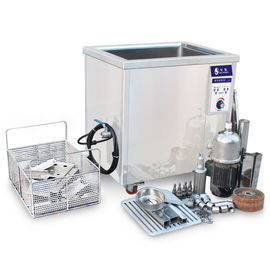RoHS Digital Ultrasonic Cleaner And Baths Use In Aerospace Manufacturing
Ultrasonic technology reaches the most inaccessible surface areas of complex aerospace components, providing much faster and far more thorough cleaning results than, spraying and manual scrubbing and a more environmentally friendly alternative to solvent cleaning.
If the tank size is not OK for you, customized machine is welcome.
Or you can directly contact sales6(at)skymen.cc for more info.
Advantages for Skymen ultrasonic cleaner:
There are many advantages to cleaning parts with Skymen Ultrasonic Cleaning Systems, not the least of which are our machine’s incredible versatility. In fact, our ‘unofficial’ motto is; If it can fit into water, you can clean it.
While the versatility is one major advantage allowing you to clean almost anything, there are several other advantages that will dramatically benefit both you and your clients/customers. These include:
- Clean Intricate Items with Ease: Ultrasonics easily reaches deep into even the most finely detailed surfaces.
- Cleans Fast: Many items can be cleaned in less than two minutes allowing you to quickly return them to your clients.
- Reduces Labor Costs: Fast cleaning means jobs can be completed in fewer hours.
- No Harsh/Dangerous Chemicals: Most items can be cleaned in just water with just a few ounces of our environmentally friendly cleaning solutions
Specifications:
| Model |
JP-120ST(digital,power adjustable) |
| Tank size |
50×30×25cm |
| Unit size |
65x46x63cm |
| wooden case packing |
85x66x93cm |
| Ultrasonic power |
240W~600W |
| Heating power |
1500W |
| Timer: |
1~99min adjustable |
| Heater |
20~80C adjustable |
| Frequency |
40,000Hz |
| Tank capacity |
38L with roller |
| G.W. |
46kg |
| power adjustable |
40%-100% |
Features:
Adjustable ultrasonic power
Original BLT type transducer
SUS304/SUS316L stainless steel tank
Adaptable for continuous operation
Adjustable thermo controller
Adjustable ultrasonic power
With separate control ultrasonic electronic generator
sweep mode control available
digital timer & heating control
boost mode& oil skimmer upon clients requirement
pressure pump and filter system are available
Certificate:
CE & RoHS

Packing & shipping:
|
Packing , loading, delivery time
|
|
Packing unit
|
1set/wooden case
|
|
Packing method
|
Export wooden case
|
|
Loading port
|
Shenzhen
|
|
Delivery time
|
About 7 working days
|
|
Minimum Order Quantity
|
1set
|
|
Transport method
|
By express company / air / sea
|
Notification:
Voltage with AC110V, signal phase, AC220V/380V three phase are no problem for us.
Please inform us when you make order.
How to choose a suitable ultrasonic cleaener?
When you contact us regarding a suitable cleaner, please provide the following information:
- What type of object do you want to clean (metal, plastic, machine part, etc.)?
- What type of contaminants do you want to remove from the object?
- How large is the object and how many do you need to clean?


Other models for your choice:


EQUIPMENT
The basic components of an ultrasonic cleaning system include a bank of ultrasonic transducers mounted to a radiating diaphragm, an electrical generator, and a tank filled with aqueous solution. A key component is the transducer that generates the high-frequency mechanical energy. There are two types of ultrasonic transducers used in the industry, piezoelectric and magnetostrictive. Both have the same functional objective, but the two types have dramatically different performance characteristics.
Ultrasonic tanks are generally rectangular and can be manufactured in just about any size. Transducers are usually placed in the bottom or on the sides, or sometimes both when watt density (watts per gallon) is a concern. The transducers can be welded directly into the tank, or watertight immersible units can be placed directly into the aqueous solution. In some instances the immersibles may be mounted at the top of the tank, facing down. For applications such as strip cleaning, one immersible is placed on top and one on the bottom, with minimal distance between them. The strip is then run through the very high energy field. A tank should be sturdy in construction, ranging from 11 to 14 gauge in thickness. Larger, heavy-duty industrial tanks should be 11 to 12 gauge and should contain the proper stiffeners for support due to the weight of the solution.
SOLUTION
The solution used in ultrasonic cleaning is a very important consideration. Solvents such as 1,1,1-trichloroethane and freon have been used effectively for many years, with and without ultrasonics. However, with the advent of the Montreal protocol, which calls for elimination of key ozone-depleting substances by 1996, companies are searching for more environmentally friendly methods to clean their parts. Chemical formulators are developing products that meet the demands of cleaning operations, yet are compatible with the health and well-being of society.
Whenever possible, it is best to use a water-based detergent in the ultrasonic cleaning process. Water is an excellent solvent, nontoxic, nonflammable, and environmentally friendly. However, it can be difficult and expensive to dispose of soiled water. Rinsing and drying can also be difficult without detergents. High surface tension exists in solutions without detergents, thus making rinsing difficult in hard-to-reach areas. Detergents can therefore be added to lower the surface tension and provide the necessary wetting action to loosen the bond of a contaminant to a substrate. As an added bonus, the cavitation energy in a water-based solution is more intense than in an organic solvent.

 Your message must be between 20-3,000 characters!
Your message must be between 20-3,000 characters! Please check your E-mail!
Please check your E-mail!  Your message must be between 20-3,000 characters!
Your message must be between 20-3,000 characters! Please check your E-mail!
Please check your E-mail! 







